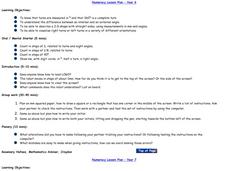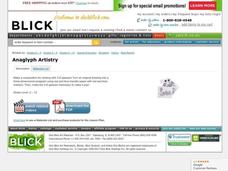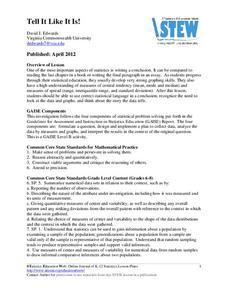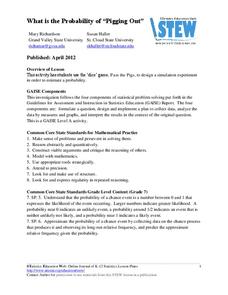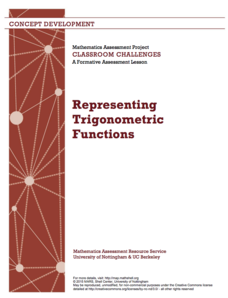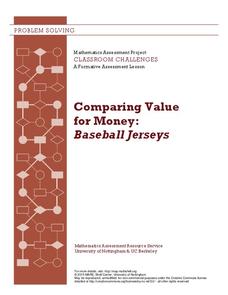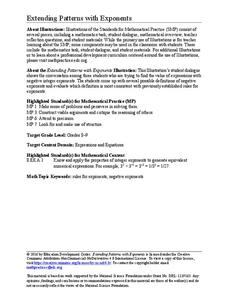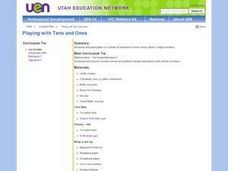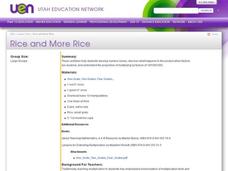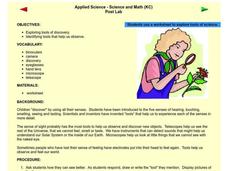Curated OER
Numeracy Lesson Plans
Students complete a series of lesson plans dealing with numbers, counting, and ordering. For this numbers lesson plan, students identify numbers, identify number patterns, count forwards and backwards, and more.
Math Drills
Standard, Expanded and Written (B)
Pupils are provided with an excellent practice learning exercise for writing six-digit numbers in standard, expanded, and written form.
Curated OER
Things in a Line
Little learners recognize symbols, objects and how to depict numbers. In this matching lesson, they can match the number names with a set of items, model ordinal numbers, and complete a cute, cartoon-character worksheet.
Illustrative Mathematics
Molly's Run
A simple lesson with a lot of support behind it. Your learners will find out how long it takes Molly to run a mile by choosing their solution method. The activity can be used as a lesson or as an independent assignment. Preface with...
Illustrative Mathematics
Fruit Salad
Playing with values in this fruit salad problem allows learners to find out how many cherries were mixed in. Your middle schoolers can organize their thoughts in a chart before going into the equation. Eigth graders can skip the chart...
American Statistical Association
Scatter It! (Using Census Results to Help Predict Melissa’s Height)
Pupils use the provided census data to guess the future height of a child. They organize and plot the data, solve for the line of best fit, and determine the likely height and range for a specific age.
American Statistical Association
Tell it Like it is!
Scholars apply prior knowledge of statistics to write a conclusion. They summarize using correct academic language and tell the story of the data.
University of Nottingham
Drawing to Scale: A Garden
See how design and geometry go hand in hand. The activity asks learners to use geometry to design a backyard garden given dimensions of each feature. Scholars work with ratios and scale to develop an accurate scale drawing that includes...
Achieve
BMI Calculations
Obesity is a worldwide concern. Using survey results, learners compare local BMI statistics to celebrity BMI statistics. Scholars create box plots of the data, make observations about the shape and spread of the data, and examine the...
American Statistical Association
What is the Probability of “Pigging Out”
Learners apply their understanding of luck to a probability experiment. They play a game of Pass the Pigs to determine the probability of a specific outcome. Using analysis for their data, pupils declare the measures of center, dot...
Mathematics Assessment Project
Representing Trigonometric Functions
Discover the classic example of periodicity: Ferris wheels. Young mathematicians learn about trigonometric functions through Ferris wheels. They match functions to their graphs and relate the functions to the context.
Curated OER
Comparing Value for Money: Baseball Jerseys
Learners step up to the plate as they first complete an assessment task using linear equations to determine the best company from which to buy baseball jerseys. They then evaluate provided sample responses identifying strengths and...
Education Development Center
Extending Patterns with Exponents
Don't think negatively about exponents. Young mathematicians dissect a fictional conversation between pupils trying to evaluate an expression with a negative exponent. This allows them to understand the meaning of negative exponents.
Mathematics Assessment Project
Comparing Lines and Linear Equations
Scholars first complete an assessment task on writing linear equations to model and solve a problem on a running race. They then take part in a card matching activity where they match equations and graphs of lines to diagrams of fluid...
Curated OER
Using the Correct Vocabulary to Solve Problems
Third graders examine the vocabulary and strategies to be used with addition, subtraction, and multiplication word and story problems. They observe the teacher solve a variety of problems, then write and illustrate their own original...
Curated OER
Playing with Tens and Ones
First graders complete a number of activities that increase their number sense and use of simple operations. They use dice and worksheets to make two-digit numbers and to record them, they count by tens and ones, and order numbers using...
Curated OER
Rice and More Rice
Fifth graders explore problem solving strategies for mathematical estimation. For this math problem solving lesson, 5th graders predict how many grains of rice are in a jar, practice establishing and looking for patterns in...
Curated OER
Subtracting Whole Numbers
Second graders practice subtracting numbers by using a visual aide. In this number sense lesson, 2nd graders complete whole number subtraction problems by utilizing manipulative cubes to visualize the equation. Students...
Curated OER
Amusement Park
In this number sense activity, 3rd graders read and solve 4 word problems involving an amusement parks parking lot, rides and admission costs. Students read one math scenario and look over a price list chart in order to solve 2...
Curated OER
Guess Again!
For this number sense worksheet, students solve 8 story problems in which clues are given for the ages of a group of people. Students figure out the age of each person in the story.
Curated OER
Numeration
In this math literacy worksheet, 1st graders practice writing numbers in the lines in order to create number sense and recognition.
Curated OER
My Test Book: Counting Practice
In this online interactive math skills worksheet, students solve 10 multiple choice math problems that require them to use their counting skills. Students may view the correct answers.
Curated OER
Musical Whole Numbers
Fourth graders participate in a musical chair activity in which they practice identifying whole numbers. In this number sense instructional activity, 4th graders listen to a song and must get in the order of the number they hold on...
Curated OER
Applied Science - Science and Math Post-Lab
Students use scientific tools. In this Applied Science lesson plan, students investigate the use of scientific tools to enhance observation and discovery. Students indicate how each tool assists scientific work.
